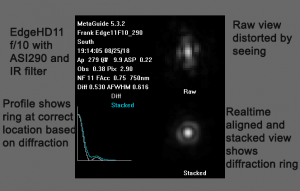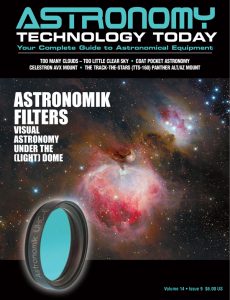The MetaGuide Collimation Service is a video-based tool to help users achieve precise collimation using the in-focus diffraction pattern of a star. MetaGuide also autoguides and has several novel features that allow optimal guiding of mid-range mounts under typical seeing conditions. MetaGuide can provide insight into both the optics of your telescope, and the tracking behavior of your mount. MetaGuide is free, easy to use, works with any type of telescope, and most video cameras. The software has been recently released in version 5.5.1 which offers updated documentation as well as many performance enhancements and bug fixes.
 As an example of how the MetaGuide Collimation Service software works, MetaGuide provides the ability to obtain sub-2″ fwhm stars with a Celestron CGE and 11″ SCT at 2800mm f.l. and 0.45″ per pixel. The key is an accurate and low latency centroid that can be chased aggressively to overcome gearbox and bearing noise. This pushes autoguiding of a mid-range mount into a realm of performance that normally requires adaptive-optics.
As an example of how the MetaGuide Collimation Service software works, MetaGuide provides the ability to obtain sub-2″ fwhm stars with a Celestron CGE and 11″ SCT at 2800mm f.l. and 0.45″ per pixel. The key is an accurate and low latency centroid that can be chased aggressively to overcome gearbox and bearing noise. This pushes autoguiding of a mid-range mount into a realm of performance that normally requires adaptive-optics.
MetaGuide has many unique features, such as real time measurement of flexure between two telescopes. This allows direct observation and measurement of flexure and mirror flop. MetaGuide also has a novel proactive guiding feature that locks onto specific high frequency gearbox or gear tooth terms that can be more of an issue than periodic error. MetaGuide also uses a novel form of “Lucky” centroiding to help determine a more accurate centroid that can be guided aggressively.
MetaGuide is highly quantitative, and provides live measurements of the radial profile of a star and its full-width at half-maximum for comparison to diffraction theory. It also measures drift, to aid polar alignment.
Although based on video guiding, MetaGuide can stack frames to create the effect of a long exposure that reaches faint guide stars. It also finds faint guide stars in the field and highlights them automatically. This avoids the user having to squint at the screen to find a guide star and then select it. When the guidestar is not faint, MG does not simply stack the exposures, but instead studies the centroid of each video frame and calculates the optimum centroid for the stack.
For the guiding component of MetaGuide, an ASCOM connection or other control of the mount must be provided (GPUSB, TOGA, AstroGene, LPT, and more).
What does the MetaGuide Collimation Service do?
– Allows a high power view of a star and its diffraction pattern even when seeing is not ideal.
– Shows a “coma dot” over the live star that guides collimation so the user just centers the dot over the star. This takes the guesswork out of collimation while keeping it interactive and realtime
– Compares the observed diffraction pattern with theory, including secondary obstruction effects.
– Provides a simple “dump” of the raw and steady images of the star, along with a plot that shows how the stellar profile compares to theory, plus numeric values for the actual and theoretical FWHM’s. This provides an objective and quantitative measure of a telescope’s true performance, with less dependence on good seeing
– Measures flexure/mirror flop using two telescopes, two web-cams, and two instances of MetaGuide that link to each other.
– Automatically re-centers the telescope during collimation so you can concentrate on the collimation adjustments and not have to re-center manually after each change.
– Acts as an autoguider with seeing effects partially removed from the error, so the “chasing of the seeing” is directly reduced.
– Locks onto a user-specified error frequency and corrects for it proactively, acting like a new level of periodic error correction that does not rely on indexing and can work at higher frequencies.
– Calculates centroid based on live view of stars using a very different algorithm than simple “center of gravity.” To reach fainter stars, the frames may be stacked first for the effect of long exposures.
– Provides graphical output and logs of drift and periodic error in your mount, including the “noise” that can be hard to remove with PEC (Periodic Error Correction).
How does it work?
– MetaGuide uses realtime image processing of the video stream to process each frame, find the star centroid, and output a realtime stacked version of the recent frames.
– Bad frames are automatically culled from the stack without user intervention.
– Normal autoguiding software assumes the guidestars are nice Gaussian shapes – but in fact they have broad and misshapen wings due to seeing. MG focuses on the central hot spot of the star in each video frame and guides on the centroids of these hot spots.
– MetaGuide is written in DirectShow/C++ for maximum performance since the amount of realtime computation is significant.
– The stacked view is magnified 4 times and aligned with sub-pixel resolution.
– This stacked view is also used as to determine guide corrections. Since this view has bad frames removed, the resulting error signal is a truer representation of the error due to the mount. This reduces the “chasing of the seeing.”
– The radial plot is calculated based on the stacked image, allowing direct comparison to theory and calculation of FWHM.
What are its requirements?
– MetaGuide requires only a video camera and Windows computer (not Win98, ME, NT, Mac, or Linux) with recent DirectX installed to perform the core diffraction analysis of a star. MetaGuide and its install package are compatible with Win7/64.
– Most video cameras are supported – of any size – along with analog video cameras (NTSC/PAL) with a simple video2usb converter. The user can specify any resolution the camera supports. The main requirement is that the camera have a DirectShow video driver.
– Modified long exposure web-cams are not supported; MetaGuide relies on streaming video to correct for seeing.
– For the guiding features of MetaGuide, a connection to the mount is needed. The mount must be either equatorial or on a wedge, and for ASCOM it must support PulseGuide.
– A view of the diffraction pattern requires high power and a stable mount, so a Barlow and good tracking may be needed. The guiding and collimation aspects of MetaGuide will work with any f/ratio.
You can learn more about the MetaGuide Collimation Service here.
 And to make it easier for you to get the most extensive news, articles and reviews that are only available in the magazine pages of Astronomy Technology Today, we are offering a 1 year magazine subscription for only $6! Or, for an even better deal, we are offering 2 years for only $9. Click here to get these deals which only will be available for a very limited time. You can also check out a free sample issue here.
And to make it easier for you to get the most extensive news, articles and reviews that are only available in the magazine pages of Astronomy Technology Today, we are offering a 1 year magazine subscription for only $6! Or, for an even better deal, we are offering 2 years for only $9. Click here to get these deals which only will be available for a very limited time. You can also check out a free sample issue here.

